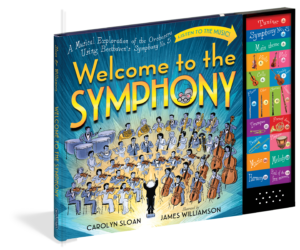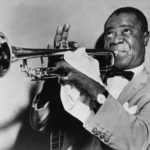Carolyn Sloan, composer, educator, and author of Welcome to the Symphony, shares 3 lively pieces that will get your kids excited about classical music.
We’re halfway through the first month of 2017, and I want to invite you to think musically about your resolutions. How about listening to some new music? It may seem like a simple change, but listening to music can be an important one for a few reasons: it’s a break from screens, a new way to engage in storytelling for our little ones and, most importantly, reinforces time spent together.
While ‘new music’ for me means modern music, for many, the music that isn’t routinely listened to is classical music. Trying this ‘new’ music can sometimes be like convincing a child that spinach is as yummy as it is good for you. Listening to classical music, especially when you’re trying to get kids to listen to it, can mistakenly be approached the same way. “It’s good for you, so listen!” If you’re already a fan, then most likely your kids are too, but if not, the trick is to introduce the unfamiliar piece in small bites (like that spinach!), through frequent exposure and integration of other familiarities while you listen.
So if you want to commit to introducing your family–and especially your children–to the world of classical music, where can you start?

To build understanding, imagination, and appreciation, take Prokofiev’s Peter and the Wolf. Prokofiev expertly tells the story of Peter and his quest to stand up to and ultimately free the wolf through different instruments that represent different characters. The whole story is told through these different timbres that build the narrative and allow the listener to understand the action without even seeing it, much like reading a good book. If you haven’t already listened to Peter and the Wolf with your kids or you don’t know it yourself, sit down, get comfortable and enjoy.
Another piece I love is Aaron Copland’s Billy the Kid ballet score. It’s a great way to hear the Wild West portrayed through music. And because it’s a ballet, it’s enormously fun to move to and enjoy while dancing. What’s more, Billy the Kid is a great example of American folklore, and can provide an interesting narrative while listening. Aaron Copland’s distinctly original style and ability to convey the American landscape, both literally and metaphorically with sound, provides us an opportunity to see how powerfully music can evoke time, place, and action. A suggestion: Billy the Kid was an outlaw. If you want to share this story with your children, you can always keep certain ‘real life’ facts out of the storytelling if you’d rather not get into explaining the escapades of a gun-slinging cowboy. Focus instead on the folklore and how well Copland conjures the West in the mid to late 1800’s.
When looking for music that incorporates great storytelling, I also love Antonin Dvorak’s New World Symphony. The melodic themes in the symphony are lush and gorgeous. Your kids will love hearing all the motifs that John Williams and other film composers pay homage to in their movie scores. Most of my students jump up and down screaming, “Star Wars!” when listening to it, because the references are so apparent. Dvorak incorporates many folk themes throughout the symphony as well, both from his homeland, the Czech Republic, and the United States. Much like in Copland’s music, Dvorak’s American folk themes represent the wide open spaces of America: the rough and tumble western part of the United States and the Midwest and Central Plains in the mid 1800s. One very famous theme in the second movement of the symphony is dedicated to the Native American Hiawatha and the conjoining of the five Native American tribes living in the Northeast.
Music is a wonderful way to listen closer to the world around you and to deepen the connections we already have with the people in our lives. I hope your year is filled with a variety of tunes–classical and beyond–and enjoyable times together.
Happy listening!
For another way to get your kids excited about classical music, check out Carolyn’s book below!
 About the Book:
About the Book:
Using one of the most famous works in classical music—Beethoven’s Fifth Symphony—here is the perfect way to introduce a young child to the world of classical music. This charming and interactive picture book with its panel of 19 sound buttons is like a ticket to a concert hall, taking readers on a journey from the exciting first moment when the musicians begin tuning up to the end of the first movement (attention newcomers: don’t clap yet!). At each step of the way, readers learn the basics of classical music and the orchestra: What is a conductor? What is a symphony? Who was Beethoven? The different aspects of music: melody, harmony, tempo, theme. And the families of instruments—strings, woodwinds, brass, and percussion.
But the best part is that every critical idea is illustrated in gorgeous sound. The sound panel allows readers to hear the different parts of the symphony and voices of the music—the famous beginning of the Fifth, what a clarinet sounds like, the difference between a violin and a viola, what a melody is, and what harmony is. Kids will want to match their voices to the A note that tunes the orchestra, dance to the rhythmic passages—and, of course, sing along to da-da-da-daah!
Buy the Book
Amazon | B&N | Indiebound | Workman





No Comments